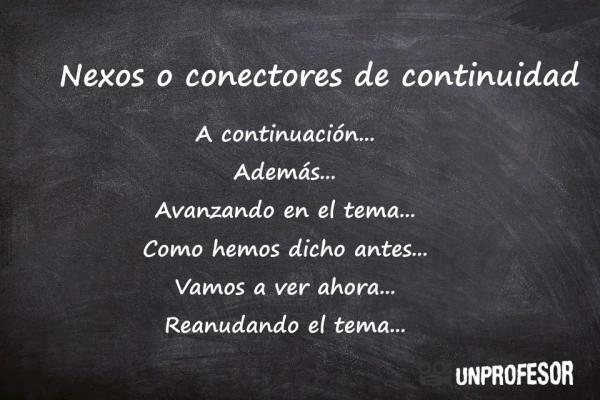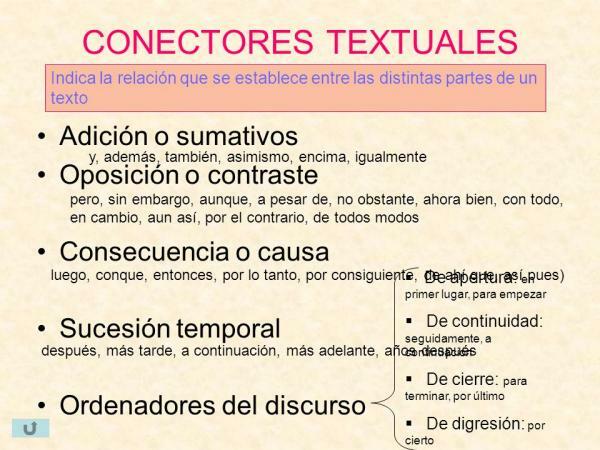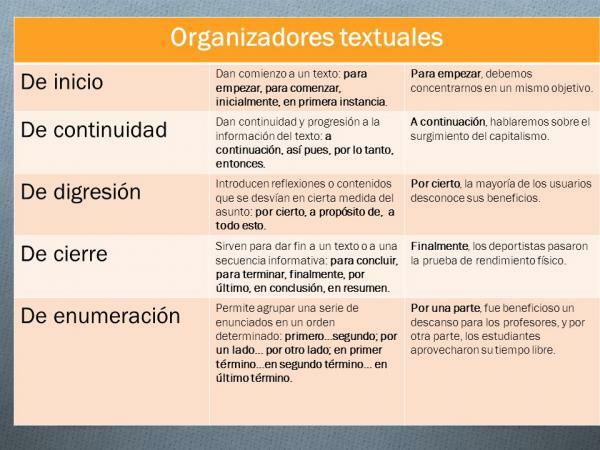What are continuity connectors

On many occasions, when it comes to correctly structure a speech contributing different ideas, it is absolutely necessary to use words that serve as links or connectors within the text itself. So that you know how to use them correctly and what their functions are, from a PROFESSOR we want to explain what are continuity connectors and some examples so that you can use them in the best possible way in your texts. Knowing them will help you create higher quality text and reinforce the message much more so that it reaches the recipient.
The continuity connectors are words that serve to join and bind different premises. That is, they are links within the text itself that help to provide a new vision of it, reinforce the arguments and clarify what has been raised by the issuer. Therefore, we can indicate that these continuity connectors provide just that, continuity to the texts so that new points of view can be contributed.
These connectors are used to link different sentences and premises that appear in the text with the aim of achieving
clarify the speech making communication between sender and receiver much more effective. Due to this, and because this function only aims at the union of different statements, the continuity connectors do not have their own meaning.Thanks to these connectors, the sender will be able to introduce new proposals in his speech so that he can better keep the attention of the person who is reading or listening to him. Search therefore, by including new arguments, further reinforce the main idea of the raised speech.
Therefore, and due to their continuity function, connectors of this type allow to structure and organize the different parts of the text so that additional explanations to the main idea are included.

Image: Slideplayer
Detecting a continuity connector within a sentence is easy without looking at some of its main features. In the previous section we have already been shelving some of its functions, but in case it is not clear yet, pay attention to the following:
- They always appear between punctuation marks: you will always find them preceded by a period between commas. It is also common to find them with a posterior coma. This also shows that these connectors are independent from the rest of the sentences.
- They seek to reinforce the discourse: because they do not have meaning by themselves, they facilitate the union of different similar premises within the text. That is, the different sentences are consonant with each other and help make the speech more accessible to the receiver, achieving better communication.
- It serves to organize ideas: continuity connectors are used to add organization within the text structure so that ideas can be distributed in paragraphs. This makes the text easier to assimilate and easier to read.
- They serve to show a transition: sometimes its objective is to mark a transition towards other approaches different from those expressed so far. It is about including new arguments to innovate within the main idea of the core argument.
Now that we have defined what continuity connectors are and we know what their main characteristics are in a text, it is necessary point out the different types that we can meet. Throughout a written creation, a multitude of them may appear due to the functions they perform in the structuring of the text. If we look at the types of continuity connectors, we can point out that there are two:
- Simple continuity connectors: they are composed of a single word that will be responsible for providing the functions explained above.
- Composite continuity connectors: different words appear in them that help you make sense within the text.
Examples of continuity links
In order to better identify them, we are going to see some examples from them. When facing a text, you will find a multitude of continuity connectors, and the use of one or the other will depend above all on the intention and vocabulary of the issuer. We show you below some of the most used:
- Then
- What's more
- Moving forward on the topic
- As we have said before
- Let's see now
- Resuming the topic
- Let's try now
- We will start by seeing
- At this point
- Returning to the topic at hand
- Following in this reasoning
- Let's go back to what we were dealing with
- Continuing with the matter
- Continuing with the exhibition

Image: Slideplayer
- After a long way lost between mountains and lakes, passing a terrible cold, the campers got, as we have said before, get to the nearest city and ask for help from the police who have been looking for them for more than a week.
- Miguel has had to stop living in the city center and move to the outskirts where the rental prices are more affordable, HoweverDespite this, his salary is not very large and he has to make a lot of efforts to make ends meet.
- Children who want to go on the field trip should sign up on the list in the hall. Then I will proceed to indicate what will be the program that will be carried out and what will be necessary for the trip.
- Co2 seems to be the cause of climate change. Continuing with this reasoning, the use of fossil fuels in cars must be reduced in the coming years to be able to reverse it as soon as possible.
- Amphibians are animals that can breathe both in the water and on the surface. In addition, thanks to their anatomy they can move very efficiently in aquatic and terrestrial environments.
You can now correctly apply continuity connectors in your texts. If you want to know more post about Linguistics and Grammar, be sure to visit our section to find other interesting articles.



